Why Sanders’ ‘Berners’ Kept Up the Heat
As a member of the California delegation, I could see that the Democratic convention was never going to be a harmonious melding of two campaigns The Clintonites were fighting not a candidate but a wildfire As a member of the California delegation, I could see that the Democratic convention was never going to be a harmonious melding of two campaigns.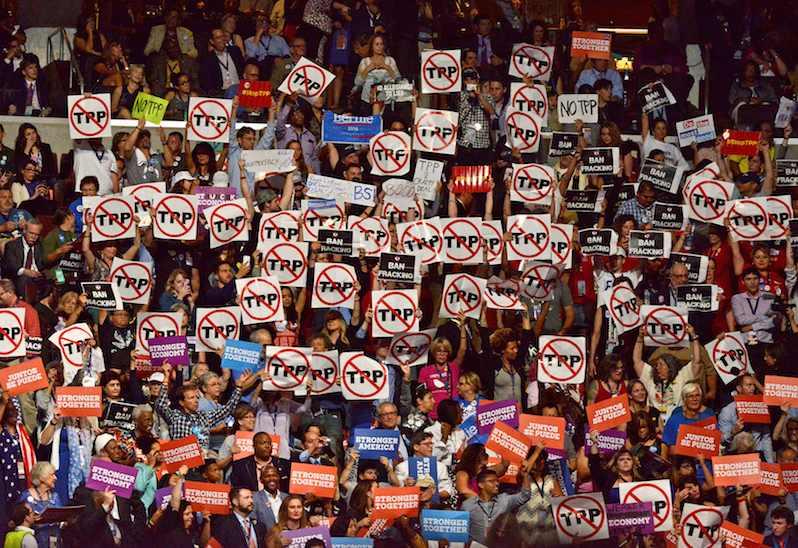 Some delegates at the Democratic National Convention held up signs protesting the Trans-Pacific Partnership. (Disney / CC 2.0)
1
2
3
4
5
Some delegates at the Democratic National Convention held up signs protesting the Trans-Pacific Partnership. (Disney / CC 2.0)
1
2
3
4
5
For the fourth straight day of the Democratic convention, I’m sitting in the California delegate section, anxiously taking in the start of the final night’s program.
In a couple of hours, Hillary Clinton will finally accept her nomination as the first female presidential nominee, breaking the glass ceiling. It will be a historic exclamation point for women and the country at large; the red, white and blue balloons are in flag formation on the ceiling, ready to drop; the whole stadium is vibrating with excitement.
Just as I am settling in, I feel a nudge on my shoulder and then my neighbor, a 20-something, blond girl in jeans and a neon green Bernie Sanders “Enough is Enough” T-shirt, points to a newly installed, gray, speaker-type thing on the wall behind us. This contraption definitely wasn’t there yesterday. My fellow California Sanders delegate explains that it’s a white noise machine—installed last night to drown out our section’s chanting. “Wow,” I think, “I really am in the eye of the storm.” Yes indeed, there can’t be any more appropriate symbol of this choreographed and sanitized convention than the foreboding, dull-gray piece of supposed suppressive technology humming 10 feet above me.
For the record, this drama was later debunked by the Democratic National Committee after a photo of it went viral—it was just a Wi-Fi antenna—but it underscores the anger, tension and paranoia that permeated much of the hall that evening. In that moment, it became clear to me that while from the outside, this convention was going to be judged a glowing success, some on the inside were viewing it quite differently.
If you’ve been paying attention to the media, you’re probably disgusted, outraged and a bit perplexed by the persistent shouting and in-your-face sign displays of the rowdy, lawless, Sanders delegation, particularly the 200 or so members from California. Why would they boo, hold up signs, stage walkouts and act as general malcontents when their losing candidate had gotten so much out of his deal with Clinton? Actually, Sanders achieved much more than most losing candidates have ever garnered in the past—through hard-fought negotiations that resulted in a platform that was indeed much more progressive than it’s been in many years. This should be grounds for unparalleled unity. So what went wrong?
I can tell you one thing: It’s all very complicated. In reality, there were two conventions going on in Philadelphia—the formal Clinton coronation and the Sanders insurgency—and both movements were operating on different planets in completely different solar systems. This convention was never going to be the harmonious melding of two campaigns, because this isn’t standard-issue politics. The Clinton campaign was not fighting a candidate, but a wildfire, whose goal by definition was to grow and thrive, not flame out. Sanders’ foot soldiers are highly emotionally involved and willing to fight to the bitter end.
Political conventions have evolved from forums for political activism and negotiation to very expensive, well-choreographed infomercials. The Philly convention in particular—because of the highly contentious nature of the primary, activist delegates, the very real Trump threat and the importance placed on the appearance of unity—was understandably extremely controlled by the Clinton campaign. This management of the message may have worked for the outside world, but it backfired with many Sanders delegates and the tens of thousands of progressive activists from all over the country protesting on the other side of the Wells Fargo Center fence, who came to have their voices finally heard and who felt completely sidelined.
Mainstream media reviews of the convention have been fawning—party unity has been achieved. However, there is an underbelly of progressive discontent, particularly among some politically active grass-roots organizers who should be party unity ambassadors, that I hope can be addressed. In my view, it’s imperative that we unite to vanquish the very real threat that is Donald Trump.
Why Was I There? Demographically, I fit the profile of a standard-issue Clinton supporter (which, post-primary, I now am). I’m an affluent, white, female, University of Chicago MBA of a certain age, a lifelong Democrat who has been in the entertainment industry for years and lives in Beverly Hills. However, I lost my heart to Sanders years ago and never looked back (I religiously listened to his “Brunch with Bernie” weekly segments on the Thom Hartmann radio show for more than a decade). I’ve always been very progressive, and my somewhat lefty roots go back to my childhood and my political science undergrad studies, particularly my university year spent in Manchester, England—the heart of the Industrial Revolution. If one is supposed to outgrow these idealistic tendencies as one gets older, I never got the memo.
I’m in Hollywood now, and during one somewhat awkward evening here last October, the day after the first Democratic debate, I hosted Sanders at my home for a meet-and-greet with Hollywood writers, actors and producers. Although we ended up having an amazing two-hour discussion and some fantastic ideas came out of it, it was clear that this was not Sanders’ turf, and he was full-bore cranky about it. He repeatedly reminded the enraptured crowd that we were not living in anywhere close to the real world here in La-La Land. One thing was for sure, however: All three of my millennial kids (and their friends) were more awe-inspired than I’ve ever seen them in their entire lives to have Sanders in their own living room—and we’ve hosted a “who’s who” of Hollywood and politics here (including Teddy Kennedy twice!). Sanders is clearly a New Age rock star for this generation.
Because of my ardent support of Sanders and my connections with the campaign, I was fortunate enough to be selected as an “at-large delegate” to the Democratic National Convention—ratified at the California Democratic convention. Most of my friends are Clinton supporters—I’m in Hollywood after all—and during the past year, I’ve been an active Sanders supporter in the community and, of course, on social media. I phone-banked and worked the Nevada caucuses. It’s been an interesting and frustrating year.
This is not my first Democratic Party rodeo. In 2004, I was on the John Kerry finance team (meaning I raised a lot of money), resulting in a position on the Platform Committee. As such, I ventured into a DNC convention full of celebrities, attended parties and hobnobbed with the political and cultural elite, ate at fancy restaurants, and had a whole lot of fun, all probably akin to what Clinton donors experienced in their tony skyboxes in Philadelphia this year. I attended the two conventions since in various capacities, and they’ve always been an invigorating, inspiring and totally enjoyable experience. Then came 2016.
The California Sanders Delegation Let me state upfront that most of Sanders’ California delegates are among the best, most impassioned, idealistic, caring, hardworking, inspiring people I’ve ever met, and it’s safe to say that I would not have ever met them in Beverly Hills. They are primarily grass-roots activists who have been inspired by Sanders’ vision of a just society that works for everyone and not just the privileged few. This is a highly diverse group: laborers, union workers, students, aspiring politicians, nurses, social and philanthropic activists, government workers, gay, straight, Latino, black—you name it. They’ve become extremely close, as people who are united by a cause often do. They call themselves the Bernie Family.
Our delegation included one of the youngest delegates, a 17-year-old Latina with sparkly eyes, glasses and an infectious smile. She became a delegate along with her 60-something, salt-and-pepper-haired, ex-laborer/union father, who taught her the door-to-door organizing tricks of the trade: Look for clues (such as war mementos or religious artifacts) in the home and use them to begin the dialogue, convincing people to first believe in the system and then to vote for your candidate, all while making them think it was their idea. Another key Sanders delegate I met was a climate warrior who wrote and fought for the platform plank that would force Clinton to have a climate summit within the first 100 days of her presidency. Alongside them was a very tall, handsome, burly ex-jock who parlayed his organizing work for Sanders into a field coordinator position for an up-and-coming Latina state Assembly candidate. To a person, these Bernie-ites worked tirelessly in their communities this year, canvassing, phoning, bringing people into the Democratic Party, registering them to vote and convincing the disenfranchised to vote for Sanders because he will help change the broken system that isn’t working for them.
It isn’t easy to become a delegate. Most are district-level, meaning that they had to campaign and run in highly competitive elections in their districts. They worked incredibly hard to be at this convention, giving up “yuuuuge” amounts of personal time, resources and energy.
Your support matters…
SUPPORT TRUTHDIG
Independent journalism is under threat and overshadowed by heavily funded mainstream media.
You can help level the playing field. Become a member.
Your tax-deductible contribution keeps us digging beneath the headlines to give you thought-provoking, investigative reporting and analysis that unearths what's really happening- without compromise.
Give today to support our courageous, independent journalists.
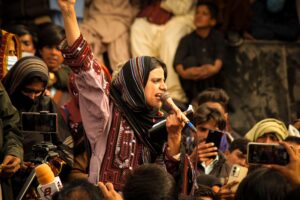
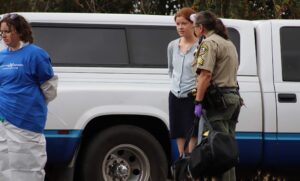

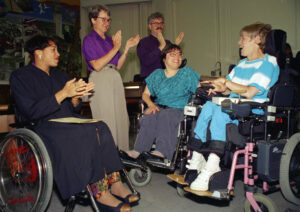
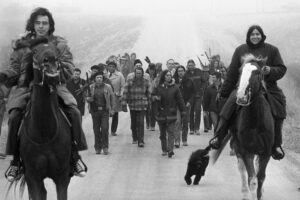

You need to be a supporter to comment.
There are currently no responses to this article.
Be the first to respond.